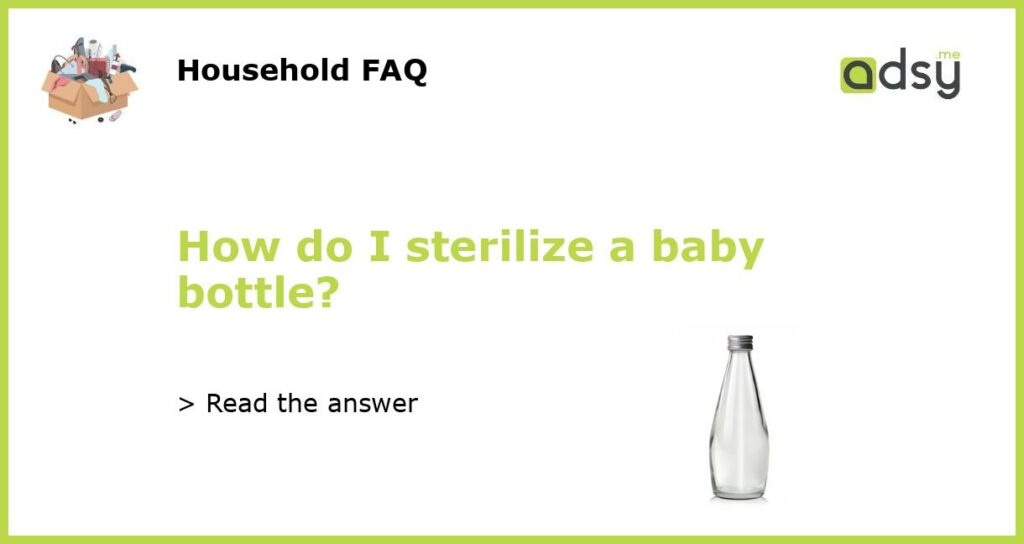Sterilizing Baby Bottles: Why It’s Important
Sterilizing baby bottles is an essential step in maintaining your baby’s health and safety. Babies have delicate immune systems that are still developing and are more susceptible to infections and illnesses. By sterilizing their bottles, you can eliminate harmful bacteria and ensure that your little one is drinking from a clean and safe container.
Different Methods of Sterilizing Baby Bottles
There are several methods you can use to sterilize baby bottles, depending on your preference and convenience. Here are a few popular methods:
- Boiling: This is the most traditional and cost-effective way to sterilize baby bottles. Simply place the bottles, nipples, and other components in a pot of boiling water for at least 5 minutes.
- Steam Sterilizer: Steam sterilizers are specially designed devices that use hot steam to kill bacteria and germs on baby bottles. They are quick and efficient, making them a popular choice for busy parents.
- Microwave Sterilizer: Microwave sterilizers work by using steam created in the microwave to disinfect baby bottles. They are convenient and save time, but make sure to follow the manufacturer’s instructions to avoid any accidents.
- Chemical Sterilizing Solution: Some parents may opt for using a chemical sterilizing solution, such as sterilizing tablets or liquid, to disinfect baby bottles. These solutions typically require a soaking period and rinsing before use.
Step-by-Step Guide to Sterilizing Baby Bottles
Regardless of the method you choose, here’s a step-by-step guide on how to sterilize baby bottles:
- Clean the bottles: Before sterilizing, make sure the bottles, nipples, and other components are thoroughly cleaned with warm soapy water. Use a bottle brush to reach all the nooks and crannies.
- Choose a sterilization method: Decide which sterilization method suits you best – boiling, steam sterilizer, microwave sterilizer, or chemical solution.
- Follow the instructions: If you’re using a sterilizer, carefully read and follow the manufacturer’s instructions. For boiling or chemical sterilization, make sure to have the necessary equipment and solution ready.
- Sterilize the bottles: Depending on the method, place the bottles, nipples, and other components in the sterilizer or pot of boiling water. Ensure they are fully submerged and allow them to sterilize for the recommended time.
- Dry and store: Once the sterilization process is complete, remove the bottles from the sterilizer or pot and allow them to air dry on a clean, dry surface. Once dry, store them in a clean and covered container or a dedicated baby bottle storage area.
Tips for Sterilizing Baby Bottles Safely
While sterilizing baby bottles is a straightforward process, here are some essential tips to ensure you’re doing it safely:
- Wash your hands: Always wash your hands thoroughly with soap and warm water before handling baby bottles or any sterilization equipment.
- Clean bottles promptly: Rinse and clean baby bottles immediately after each use to prevent milk residue from hardening and becoming harder to clean.
- Regularly check bottle condition: Inspect baby bottles for any signs of damage or wear. If you notice cracks, chips, or discoloration, replace the bottle to maintain hygiene.
- Follow manufacturer’s instructions: Whether you’re using a sterilizer or chemical solution, make sure to carefully read and follow the manufacturer’s instructions for safe and effective sterilization.
- Be cautious with microwave sterilization: If using a microwave sterilizer, use caution when handling the hot bottles and ensure they have cooled down before removing them from the microwave. Follow the manufacturer’s instructions carefully to avoid any accidents or burns.
How Often Should You Sterilize Baby Bottles?
The frequency of sterilizing baby bottles may vary depending on your baby’s age and overall health. As a general guideline:
- Newborns: It is recommended to sterilize baby bottles for newborns until they are at least 3 to 4 months old, as their immune systems are still developing.
- Older babies: Once your baby reaches 3 to 4 months, you can transition to washing bottles with hot soapy water and rinsing them thoroughly. However, you may choose to continue sterilizing periodically.
- When in doubt, sterilize: If your baby has been ill or is particularly vulnerable, it’s always better to err on the side of caution and continue sterilizing bottles regularly.
Remember, keeping your baby’s bottles clean and sterilized is an important part of their overall well-being. By following proper sterilization techniques and guidelines, you can help protect your little one from harmful bacteria and ensure their health and safety.






